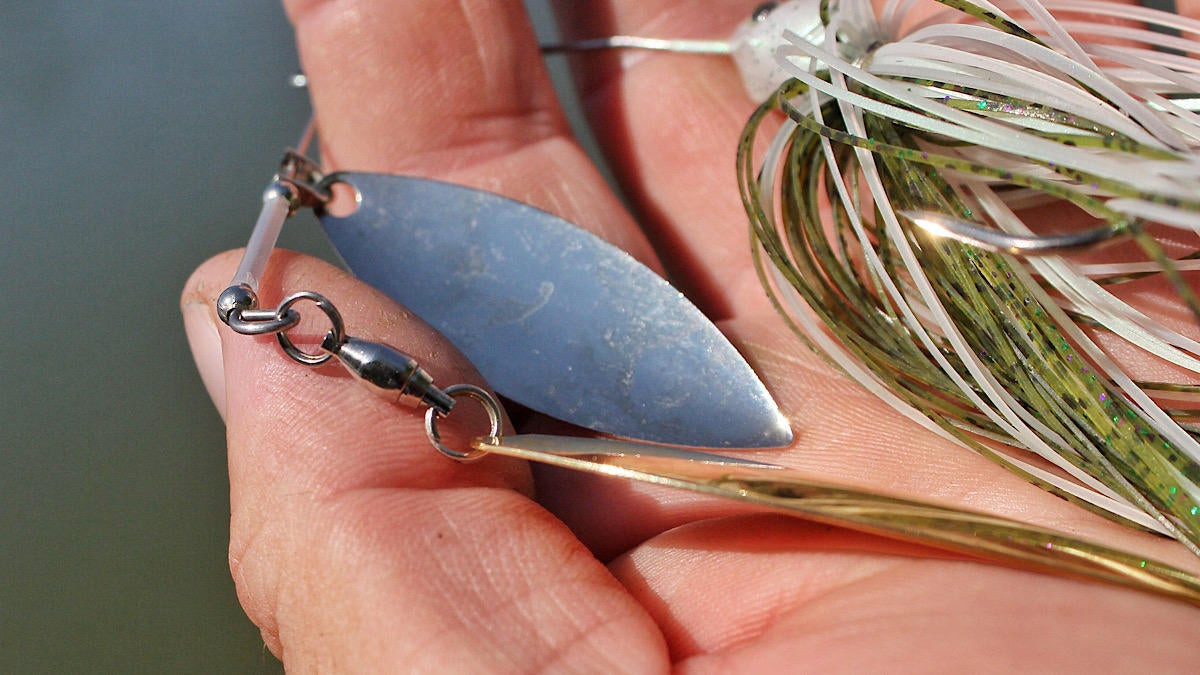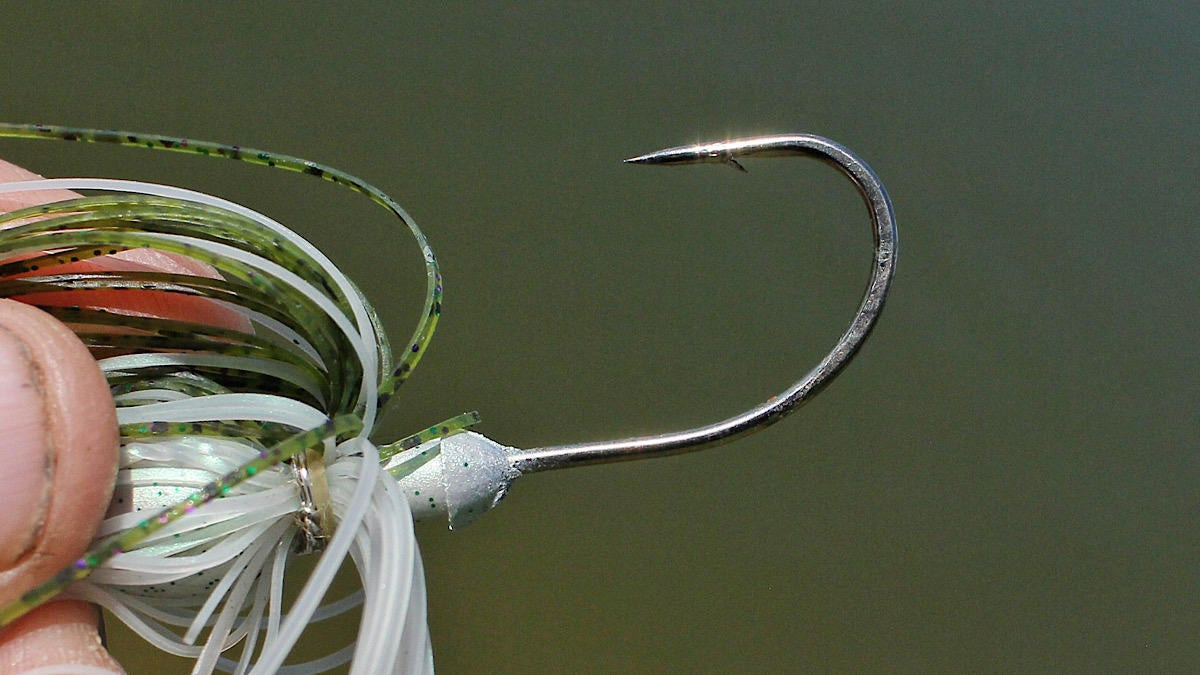Fall is almost here, even though it doesn’t really feel that way. Here in Alabama, it’s as hot right now as it’s been all year and going to be just as hot for the next few weeks. But just one mere month away, fall will officially begin. September 22, 2021 will usher in the end to another brutally hot summer here in the south and bring on the refreshing cooler nights and then cooler days of the fall. With that change in season, the double willow leaf spinnerbait will also circle back around in the rotation.
Though you can catch a bass on a double willow leaf spinnerbait anytime of the year, it’s one of the true front runners of fall fishing. So today we’re going to offer up our review of the Strike King Tour Grade Double Willow Spinnerbait in time for you to see if you want to test it out for yourself this fall. We think you just might.
Overall build and price point
For starters, the “Tour Grade” in the name of the Strike King Tour Grade Double Willow Spinnerbait is an appropriate labeling for it. You see a lot of companies now use the terminology of “tour” or “elite” when labeling some of their higher-end baits. This is meant to indicate that a bait is a step above others, even in their own lineups. The lures will have more durable components or a few more bells and whistles which increase the overall quality of the bait and typically, the price tag.
While the Tour Grade Double Willow from Strike King does have top-notch components throughout, a few of which we’ll talk about in this piece, I was pleased to see they kept the price point reasonable at $7.99 for the 3/8-and 1/2-ounce models and $8.99 for the 3/4-ounce. Strike King could have bumped the price up a dollar or two and been justifiable in doing so and still stayed competitive with other branded baits in the same tier. So I’d start off by saying it’s definitely a reasonably priced bait for the quality. But let’s talk a little more about the details of that quality.
A look at the arm
Looking at everything from the wire of the spinnerbait out to the blades, Strike King put a good combination together. The wire is fairly light, allowing for good vibration with the willow leaf blades. If the diameter were bigger and the tension of the wire tighter, the blades wouldn’t have as much flash or vibration in the water. For Colorado blades that have a harder thump to them, it’s okay to have a thicker wire for the arm. But with willow leaf blades, thinner is better… to a degree.
You can go too thin however, which leads to a lot of bending and inevitable breaking of the arm; so it’s a fine art to dialing in the right diameter. While the 7-pounder in the pictures with this piece did bend the arm, the average 1- to 2-pounder won’t cause a problem. And this big one would have likely bent any spinnerbait. A quick readjusting and it was back in the water. But without the light wire to allow the blades to do their thing, the bass may not have bitten at all.
Remaining components on the arm
The blades, swivel, beads and plastic spacer on the arm all work well together. The swivel is where the real magic happens though and when building a spinnerbait, it is extremely important. My dad and I have built our own spinnerbaits for years and in doing so, found quickly that you don’t want to skimp on the swivel.
A cheap, junky swivel will regularly get into a bind and the blade will just kind of flail around on the end of the arm instead of spinning. This happens a lot when fishing around cover. Even with a bad swivel, once you get the blade turning it will typically keep turning. But if you’re using a bad swivel and bump into a stump, rock or even a blade of grass, it’ll knock the blade off course and then you’ll have to pump your rod tip several times to try to get it back going, if you even realize it’s messed up at all.
The more you fish with a spinnerbait, you’ll get to where you can tell by the feel of it if the blades are turning. The swivel is such an important and costly part of building spinnerbaits that it’s the one thing dad and I will recycle when we’re building our own. It the arm breaks on a spinnerbait or it just gets old and of no use, we’ll take a pair of dykes and cut the wire of the arm to free the swivel up from the old spinnerbait and then swap it over to a new one. So kudos to Strike King for not cutting corners there.
Hand-tied skirt
Another next level move with the construction of this spinnerbait is the use of a metal wire tie to secure the skirt. Using metal or thread instead of a rubber collar to secure skirts on jigs, spinnerbaits, vibrating jigs and buzzbaits is referred to as hand tying them. This method requires a little more time and is often reserved for higher end baits. But it does a much better job of keeping the skirt on the bait than a rubber collar does.
The one drawback is that sometimes the wire will actually cut through the silicone skirting. When looking closely at the Tour Grade spinnerbait, it looks as though Strike King used a combination of a rubber collar and hand-tied metal wire to secure the trailer, using the collar to protect the skirting from the sharp metal wire. I’ve seen this done on a few baits and it’s a very effective method and good combination of the best of both worlds.
Hook
The business-end of this bait is set up nicely as well. There’s a trailer keeper sticking just below the collar-area of the skirt. It’s one of the round trailer keepers as opposed to the barbed ones you see on a lot of baits. I like both but I will say this one tends to do better with the super stretchy soft plastics like Z-Man’s ElaZtech material. And I use those type baits as trailers often on a spinnerbait to prevent fish from biting the tails off and having to re-rig another trailer and trailer hook. So I like this style trailer keeper pretty good personally.
Then moving to the hook, it has a good length and bend to it. I believe this style hook is referred to as having an O’Shaughnessy bend. I like this bend on jigs and spinnerbaits. It’s a strong and sharp hook built to withstand big fish without bending. And this particular hook on the Strike King Tour Grade Double Willow Spinnerbait has stood up to that task as well.
In conclusion
I like a good spinnerbait and this is certainly a good spinnerbait. The Tour Grade Double Willow from Strike King comes in at a reasonable price point for a solid spinnerbait. Quality components, a strong and sharp well-designed hook and a hand-tied skirt put this spinnerbait a notch or two above average. Dialing in a a thin wire that’s not quite too thin ensures this bait will get a big one to bite as well as get her to the boat. All in all, another solid product from Strike King. No surprise there.
The Strike King Tour Grade Double Willow Spinnerbait is available at the following retailers:


















